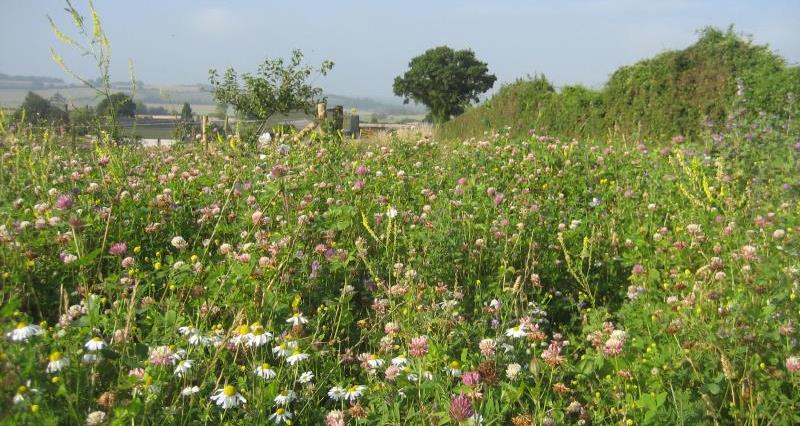The expansion of SFI does increase the opportunities to engage and create different habitats across the arable landscape.
However, its challenging to work through which SFI actions to use.
All farms should be looking to include the three planning actions:
- Have an integrated pest management plan (CIPM1 – £1,129/year).
- A nutrient management plan (CNUM1 – £652/year).
- Produce a soil management plan and keep soil organic matter tests up to date (CSAM1 – £6/ha + £97 per year).
Boundary actions
In addition, there are boundary actions available.
The SFI introduced a number of actions not previously available in agri-environment schemes. For the first time you can be paid to do no-till – strip tillage is not allowed – (SOH1 – £73/ha), have a companion crop (CIPM3 – £55/ha), not to apply insecticides (CIPM – £45/ha) or apply nutrients using variable rate applications (PRF1 – £27/ha).
Defra has introduced spring (SOH2 – £163/ha) and summer cover (SOH3 – £163/ha) crops in addition to the existing winter cover crop (CSAM2 – £129/ha).
These all aim to protect and improve soil structure. This can’t be one continuous cover used to claim all three payments. There is a requirement to overseed, if you are leaving the cover in place i.e. you can’t be paid for the same action twice.
Rotational options
NFU lobbying secured helpful changes to the draft SFI expanded offer actions originally published in May.
Both legume fallow (CNUM3 – £593/ha) and herbal leys, which are available on arable land, (CSAM3 – £382/ha) can be rotated.
You still have to have both actions in the ground long enough to deliver the aim of the action. For legume fallow, it should flower from late spring and during the summer for wildlife and winter green cover to protect the soil.
Wildlife actions
There are many actions for creating areas for wildlife. You may want to locate these around the edges of fields or on the less productive areas.
They have potential to support your crop through providing habitat for beneficial insects. These include grassy field corners (CAHL3 – £590/ha), pollen and nectar mix (CAHL1 – £739/ha), cultivated areas for arable plants (AHW11 – £660/ha) and bumblebird mix (AHW1 – £747/ha).
To support birds over winter, there’s a winter bird food action to plant a mix (CAHL2 – £853/ha) and a supplement (AHW2 – £732/tonne per year) to provide seed in the late winter months.
Within the cropped area, beetle banks (AHW3 – £764/ha) could be deployed. They could have the added benefit of slowing water flow across the field or stopping soil erosion. There are opportunities to provide lapwing (AHW5 – £765/ha) or skylark plots (AHW4 – £11 per plot).
In addition, there are actions to protect environmental features e.g. hedges (4 – 12m buffer CAHL4 – £515/ha), watercourses (12 – 24m buffer BFS1 – £707/ha), ponds (BFS2 – £681/ha) and in field trees (BFS4 – £553/ha).
Rotational areas
The first SFI23 agreements are about to start their second year.
To allow for variations in field size, the area of rotational options can be increased or decreased for years two and three of the agreement. If you reduce the area, it should be at lest 50% of the area in year one.
There is no limit on the increase in area. You do need to stay within the 25% for the limited area actions. Your payments for the next year will change to reflect the new areas.
25% limited area actions
Ten SFI actions are limited to 25% of the farm. This applies to agreements that were applied for on, or after, 26 March.
If you have more than one SFI agreement, the 25% limit applies to the combined area of the limited actions across those agreements.
The ten ‘limited actions’ are:
- CIPM2: Flower-rich grass margins, blocks, or in-field strips (IPM2 in the SFI 2023 offer).
- CAHL1: Pollen and nectar flower mix (AHL1 in the SFI 2023 offer).
- CAHL2: Winter bird food on arable and horticultural land (AHL2 in the SFI 2023 offer).
- CAHL3: Grassy field corners or blocks (AHL3 in the SFI 2023 offer).
- CIGL1: Take improved grassland field corners or blocks out of management (IGL1 in the SFI 2023 offer).
- CIGL2: Winter bird food on improved grassland (IGL2 in the SFI 2023 offer).
- WBD3: In-field grass strips.
- AHW1: Bumblebird mix.
- AHW9: Unharvested cereal headland.
- AHW11: Cultivated areas for arable plants.
‘Whole field’ actions
Some SFI actions require the whole available area of the field to be entered into them. This is different to whole field. The available area of the field is that left after the deduction of incompatible areas.
No till (SOH1) is a whole available area action. This will be the area left after the removal of ineligible features such as ponds and incompatible actions e.g. pollen and nectar mix CAHL1.
When completing the application form, you are advised to apply for all the other actions in the field, before adding the no-till action SOH1.
Future Countryside Stewardship Higher Tier offer
Outline information on the future Higher Tier offer was published in May. The NFU is lobbying for the full details to be published and the scheme to be launched.
The NFU is concerned that CS (Countryside Stewardship) agreements ending in December will not have sufficient time to develop a new agreement to start on 1 January. Defra needs to put in plans to support these agreement holders.
Transferring from CS Mid Tier and HLS to SFI
The previous government promised it would be possible to move from CS Mid Tier or HLS into SFI by this autumn. The NFU is lobbying for the new government to put an automatic process in place to enable these agreement transfers to happen. If you do want to undertake a transfer before the automatic process is in place, please contact the RPA.

